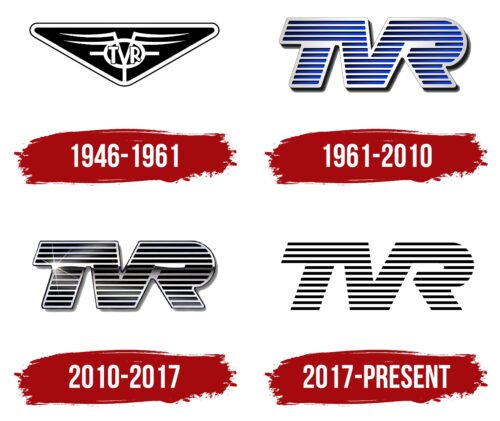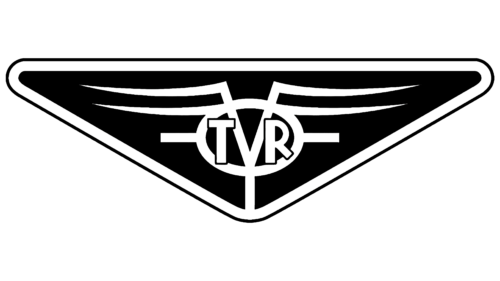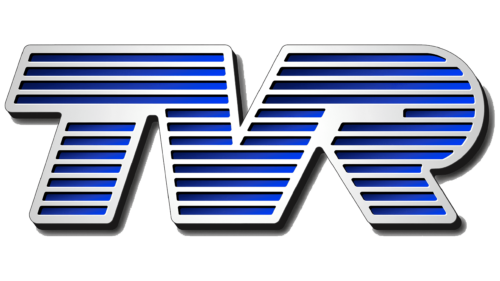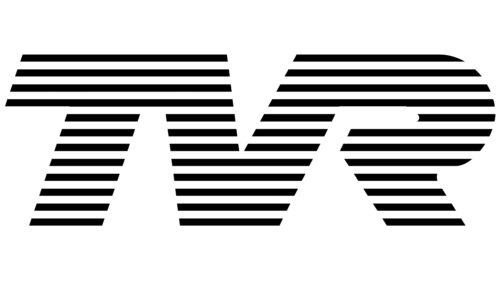The TVR logo exemplifies a successful evolution from a complex form to a simple one. The concise and unobtrusive symbol showcases the significant capabilities of the British company. The emblem clearly conveys sports cars’ dynamics, speed, and unstoppable energy.
TVR: Brand overview
In 1947, a young engineer named Trevor Wilkinson established Trevcar Motors, a modest business in Blackpool, England, marking the beginning of TVR’s history. The company’s initial focus was on auto maintenance and customization. TreVoR, the founder’s name, inspired the eventual moniker TVR.
Wilkinson constructed his first automobile in 1949 using an Alvis Firebird chassis. This experience motivated him to design his own sports cars. The brand’s inaugural vehicle, the TVR Sports Saloon, debuted in 1953. It was constructed with parts from various manufacturers on a tubular frame.
The company underwent research and experimentation during the 1950s. The Open Sports and Coventry Climax were two of the models developed. These vehicles were made in limited quantities and were primarily used for racing.
The brand’s first commercially successful car, the Grantura, debuted in 1962. Sports car enthusiasts liked the Grantura due to its lightweight design and superior handling.
The Griffith 200, featuring a potent Ford V8 engine, was introduced in 1965. This vehicle solidified the company’s reputation as a fast and exhilarating sports car producer and set a new benchmark for performance.
The manufacturer kept expanding its model line during the 1970s. The 1600M, 2500M and 3000M models of the M Series were released. These vehicles had better build quality and improved designs.
The 1980s were a time of significant transformation. Peter Wheeler, a prominent businessman and motorsport enthusiast, bought the company in 1981. Under his direction, the brand started making more forceful and aggressive models.
The Tasmin debuted in 1982 and later developed into the 350i and 450SE series. Due to their powerful engines and angular designs, these vehicles were well-liked by speed enthusiasts.
The 1990s were a golden age for the company. Several legendary models were introduced, such as the Griffith, Cerbera, and Chimaera. Purists favored these vehicles for their distinctive styling; powerful engines built in-house, and absence of technological driving assistance.
The company continued making high-end sports vehicles in the 2000s. New models such as the Sagaris, Tamora, and Tuscan were released. These vehicles were renowned for their magnificent performance and flashy looks.
However, financial issues arose by the mid-2000s. In 2004, Peter Wheeler sold the business to Nikolai Smolenski, a young businessman from Russia. Despite the new owner’s lofty goals, the business could not overcome its financial problems.
In 2006, the company stopped making cars. In the ensuing years, numerous attempts were made to revive the brand, but none were successful.
Les Edgar led a group of investors that purchased the company in 2013. The new owners revealed plans to revitalize the brand and create new models.
The new Griffith was unveiled in 2017 to reintroduce the brand to the market. However, numerous obstacles and delays prevented the model’s production.
Meaning and History
What is TVR?
It is a British company that produces sports cars known for their unique design, lightweight construction, and powerful engines. The company has a long tradition of creating limited edition hand-built cars where the thrill of driving is put above comfort and practicality. The brand’s models, such as the Sagaris, Griffith, and Chimaera, are known for their consistent emphasis on driver interaction, aggressive styling, and high performance. Rear-wheel drive, powerful naturally aspirated engines, and fiberglass bodies are common features of the brand’s vehicles that provide an intense and visceral driving experience.
1946 – 1961
The British identity is reflected in the main element of the TVR logo – a triangular shield. This common feature in heraldic symbols and seals signifies high status. The newly established company aimed to present itself as an experienced and important player in the automotive industry, selecting a serious and meaningful emblem. It concentrates a businesslike energy, conveyed through:
- Perfectly straight and smooth lines
- A clear triangular structure
- Precise centering of internal elements
- A two-component frame
- Use of two highly contrasting colors
The shield has no sharp corners, but it is rounded to signify increased attention to consumers and symbolize the safety of the manufacturer’s cars. Sharp ends are present only in the stylized wings derived from the “V.” This harmonious and professional image effectively represents the cars’ high speed, responsiveness, lightness on the roads, agility, and maneuverability.
The improvised feathers (two on each side) resemble flags waving atop ancient British castles, referencing the company’s authenticity, roots, and unique character. The two adjacent letters carry no additional meanings, simply representing the abbreviation “TVR.” The glyphs are bold, contoured, grotesque, and uppercase, designed in an informal style, as indicated by the shortened right leg of the “R.” It is disproportionate and whimsical, reminiscent of fonts for a younger audience.
The shield’s center features an oval, serving as the background for the abbreviation. Long stripes of equal width extend from its right, left, and bottom. The central stripe drops lower than the side ones, connecting with the frame. These lines perfectly echo the improvised wings, resembling classic speed lines used in logos to convey motion.
The emblem is monochromatic and colored in black and white. This combination is common in branding, as it helps convey the company’s businesslike nature, express seriousness, and emphasize practicality. Black represents elegance, strength, wealth, and mystery, while white embodies purity, kindness, truth, and honesty.
1961 – 2010
This period marked the introduction of a logo with a striped abbreviation. It remained for many years, making the brand widely recognizable. The main (and only) element is the name of the automobile company. The inscription serves a dual function, as it represents:
- Text
- Image
This design presented the car manufacturer as thoughtful, meticulous, and highly attentive to detail, indicating that the company applies the same standards to car production, focusing on quality. The smart choice of the emblem demonstrates its ability to stay on the market despite challenges.
The inscription features an extra-bold font with monolithic uppercase letters. The designers skillfully merged the glyphs so they appear as a unified whole and are easily readable, even though the side strokes of “V” are parts of the adjacent “T” and “R.” This assimilation did not negatively impact the text, which remains legible and effectively represents the British company. The letters are slightly tilted, allowing the logo to convey a sense of dynamism.
The horizontal stripes that form the abbreviation well represent movement. These stripes seem carved into the glyphs, appearing recessed—at least the blue lines. The white lines, in contrast, seem raised above the surface. These stripes are perceived as speed lines, reminding viewers of high speed, dynamism, and maximum energy.
A solid white border runs along the edges of the letters. Short double lines appear in the middle of the “T” and “R.” One of these lines indicates an intra-letter space (in the “R”), while the other balances the design, as the “T” inherently lacks such a space. This harmonizes the emblem, adds originality, and supports the overall concept. The inscription appears neat, realistic, and three-dimensional, with the correct distribution of shadows and highlights.
2010 – 2017
Even though the TVR logo became black and white, it gained incredible brightness. This effect was achieved through the use of highlights, which stood out due to professional shadow distribution. The form and content of the emblem remained unchanged.
The logo is based on the name and has block letters in uppercase. The letters are so large that they fill the entire space, serving as graphic symbols themselves. Each glyph is marked with alternating horizontal stripes. A gradient was added this time, giving the white lines at the top a gray tint. This is effectively combined with a creamy color, giving the entire light surface a metallic texture with a chrome shine.
A particularly bright light flash stands out on the left part of the “T.” It symbolizes car headlights and the reflection of sunlight on the glass, suggesting that the sports cars from this manufacturer are the latest models, unmatched in speed, endurance, and reliability. Their technical perfection and beautiful design bring joy to their owners and dazzling car enthusiasts.
2017 – today
The TVR emblem of this period is two-dimensional. It embodies modernity, modernism, and even innovation, offering a new perspective on familiar things.
- The logo is flat, meeting current visual identity requirements to be clear when viewed from displays and other information sources.
- The transition between the letters is seamless: the middle glyph is fully integrated with the two neighboring ones. Both sides of the “V” are parts of “T” (the fragment of the top) and “R” (the entire left leg).
- The abbreviation features a zebra pattern: the alternation of black and white creates a unique, almost hypnotic effect, fitting perfectly into the flat logo format.
While the brand mark has lost its metallic texture and shine, it retains its dynamism. The slanted letters, composed of many speed lines, appear active as if they are moving forward, overcoming difficulties without noticing obstacles.
This creates a positive consumer perception of the British company and its products. Despite years and challenges, the company has maintained its identity through a unique emblem that successfully represents it in the international market.








